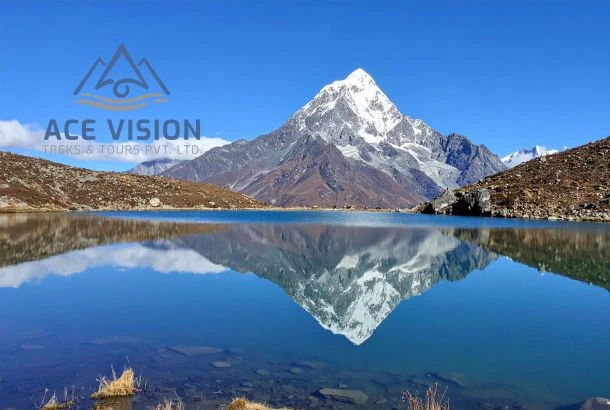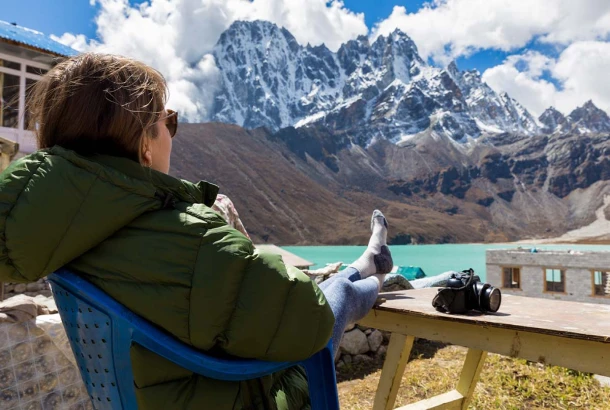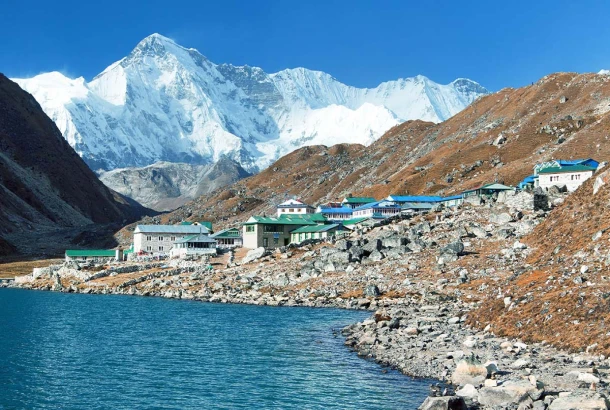Nepal with its breathtaking landscapes and majestic peaks, is a haven for trekking enthusiasts. The Himalayas, home to the world's highest mountains, offer unparalleled beauty and adventure. However, amidst the excitement of embarking on a trek in this remarkable region, one must be aware of the potential risks, particularly altitude sickness. In this blog, we will talk in detail about altitude sickness, its symptoms, prevention, and management while doing some famous treks in Nepal.
Altitude Sickness: A Guide for Trekking in the Himalayas of Nepal
Table of Contents
Altitude Sickness:
Altitude sickness, known as acute mountain sickness (AMS). It is a condition caused by decreased availability of oxygen at high altitudes. It primarily affects individuals who ascend rapidly to altitudes above 2,500 meters (8,000 feet). The severity of symptoms varies from mild discomfort to life-threatening conditions like high-altitude pulmonary edema (HAPE) and high-altitude cerebral edema (HACE).
At higher altitudes, the air becomes thinner, which means there is less oxygen available for the body to function properly. This lack of oxygen can lead to various symptoms and, in severe cases, can become life-threatening. The severity of altitude sickness can vary from person to person and can also depend on factors such as the speed of ascent, individual susceptibility, and overall health.
Altitude sickness symptoms during trekking
Common altitude sickness symptoms include:
- Headache: Persistent, throbbing headache is often the first symptom of altitude sickness.
- Fatigue and Dizziness: Feeling tired, weak, and experiencing dizziness or lightheadedness.
- Nausea and Vomiting: Loss of appetite, feelings of nausea, and sometimes vomiting.
- Shortness of Breath: Difficulty breathing, especially during physical exertion.
- Insomnia: Trouble sleeping or experiencing restless nights.
- Rapid Heartbeat: Increased heart rate or palpitations.
If left untreated, altitude sickness can progress to more severe forms. High altitude pulmonary edema (HAPE) involves fluid accumulation in the lungs, resulting in breathlessness and coughing, often accompanied by a frothy pink or white sputum. High altitude cerebral edema (HACE) is a potentially life-threatening condition that affects the brain, causing symptoms such as confusion, disorientation, loss of coordination, and even coma.
Prevention and management of altitude sickness involve several strategies, including gradual ascent to allow for acclimatization, staying well-hydrated, maintaining a balanced diet, and using medications like acetazolamide (Diamox) to aid in prevention. If symptoms of altitude sickness occur, it is crucial to descend to a lower altitude immediately and seek medical attention if necessary.
Note that altitude sickness can affect anyone, regardless of age, fitness level, or prior experience at high altitudes. Therefore, it is essential to be aware of the symptoms, take necessary precautions, and listen to your body when trekking or traveling to high-altitude destinations.
Types of Altitude Sickness
Three main types of altitude sickness occur at high altitudes: acute mountain sickness (AMS), high altitude pulmonary edema (HAPE), and high altitude cerebral edema (HACE). These conditions range in severity. It's important to recognize their symptoms and seek appropriate medical attention if necessary. Let's explore each type in more detail:
Acute Mountain Sickness (AMS):
Acute mountain sickness is the mildest form of altitude sickness and is the most common type. It typically occurs when ascending to altitudes above 2,500 meters (8,000 feet) too quickly. Symptoms of AMS usually develop within a few hours or up to a day after reaching a high altitude.
Common symptoms include:
- Headache (often throbbing or pounding)
- Fatigue and weakness
- Dizziness or lightheadedness
- Nausea and vomiting
- Loss of appetite
- Insomnia
- Shortness of breath
- Rapid heartbeat
AMS symptoms are generally self-limiting and improve with rest, hydration, and proper acclimatization. However, if symptoms worsen or if more severe symptoms develop, it may be necessary to descend to a lower altitude.
High Altitude Pulmonary Edema (HAPE):
High-altitude pulmonary edema is a more severe form of altitude sickness that affects the lungs. It occurs at altitudes above 3,000 meters (10,000 feet). HAPE is more commonly seen at higher elevations. It is characterized by the accumulation of fluid in the lungs, leading to breathing difficulties.
Symptoms of HAPE include:
- Severe shortness of breath, even at rest
- Persistent cough (often with pink or frothy sputum)
- Fatigue and weakness
- Chest tightness or congestion
- Blue lips or fingernails (due to inadequate oxygenation)
HAPE is a serious condition that requires immediate medical attention. Descending to a lower altitude is critical, and supplemental oxygen and specific medications are necessary to treat the condition.
High Altitude Cerebral Edema (HACE):
High-altitude cerebral edema is the most severe and life-threatening form of altitude sickness. It occurs when there is fluid accumulation in the brain due to prolonged exposure to high altitude. HACE is a medical emergency and fatal if not treated promptly.
Symptoms of HACE include:
- Severe headache that does not improve with rest or medication
- Mental confusion or disorientation
- Loss of coordination and balance
- Irrational behavior or hallucinations
- Nausea and vomiting
- Seizures
Immediate descent to a lower altitude is crucial with quick medical attention. Treatment often involves administering supplemental oxygen and specific medications.
Altitude sickness during famous treks in Nepal
Below are the best teahouse base treks in Nepal:
Famous Teahouse trekking packages
Everest Gokyo Valley Trek
Everest Gokyo Valley trek takes trekkers through the stunning Khumbu region of Nepal, offering breathtaking mountain vistas, serene lakes, and a chance to witness the mighty Mount Everest up close. The trail is rugged and steep. You trek within the Sagarmatha National Park. Starting from lush rhododendron forests, following the Dudh Koshi River, the trail ascends above the tree line and goes through rocky tracks and moraines. The later part of the trail also navigates via the Khumbu Glacier moraine.
- Altitude Profile: The Everest Gokyo Valley takes hikers through varying altitudes, starting from Lukla (2,860 m/9,383 ft) and reaching its highest point at Gokyo Ri (5,357 m/17,575 ft). The trek includes several significant ascents and descents, passing through Namche Bazaar (3,440 m/11,286 ft), Dole (4,040 m/13,254 ft), Machhermo (4,470 m/14,665 ft), and Gokyo village (4,790 m/15,715 ft) before returning to Lukla. If the itinerary includes excursions to EBC and Kala Patthar, you will touch altitudes up to 5,545 meters (18,192 ft).
Manaslu Circuit Trek
The Manaslu circuit trek route follows the Budhi Gandaki River, crossing suspension bridges, waterfalls, and terraced fields. As you ascend, the landscapes transition from lush greenery to alpine forests and eventually to arid and rugged terrain surrounded by snow-capped peaks. During the trek, you'll come across ancient monasteries, Chortens (Buddhist shrines), and prayer flags that reflect the rich Buddhist culture prevalent in the region. Observing the rituals, interacting with the locals, and learning about their way of life adds a unique cultural dimension to the trek.
- Altitude Profile: The Manaslu circuit trek reaches its highest point at Larkya La (pass), situated at an altitude of 5,106 meters (16,752 ft). Trekkers gradually ascend from Soti Khola (700 m/2,296 ft) through various villages like Deng (1,860 m/6,102 ft), Namrung (2,660 m/8,727 ft), Samagaon (3,530 m/11,581 ft), and Samdo (3,875 m/12,713 ft). The terrain includes lush forests, river valleys, and rugged, steep gorges.
Upper Mustang Trek
This trek takes you to the remote and culturally rich region of Upper Mustang, known for its unique landscapes and ancient Tibetan Buddhist traditions. The trail goes through arid valleys, picturesque villages, and ancient monasteries, providing a glimpse into the traditional Tibetan way of life. The rugged terrain and challenging trails require physical fitness and endurance. Trekking in Upper Mustang offers a unique experience, as the region was restricted to foreigners until 1992, preserving its cultural heritage. The Upper Mustang trek allows you to explore the walled city of Lo Manthang, visit centuries-old monasteries, and interact with the friendly locals.
- Altitude Profile: The Upper Mustang Trek reaches altitudes above 3,000 meters (9,842 ft), with Lo Manthang being the highest point at around 3,840 meters (12,598 ft). The trek passes through villages like Kagbeni (2,800 m/9,186 ft), Chele (3,475 m/11,400 ft), Ghami (3,500 m/11,482 ft), Charang (3,560 m/11,679 ft) and Lo Manthang (3,730 m/12,237 ft), and the terrain varies from arid valleys to rocky trails and high mountain passes. The highest point reached on this trek is Lo La Pass, at 4,010 meters (13,156 ft).
Everest Base Camp Trek
As trekkers make their way to the iconic base camp of the world's highest peak, Mount Everest, they encounter high altitudes that lead to altitude sickness. With our perfect Everest Base Camp Trek itinerary that has ample rest days, anyone can bypass altitude sickness. The trail meanders through forests, river valleys, and glacial moraines, offering spectacular views of snow-capped mountains and glaciers. As trekkers ascend, the landscapes become more rugged and barren, creating a sense of awe and adventure. With its unique flora and fauna, including rhododendron forests, rare mountain animals, and colorful prayer flags, the EBC trek offers a very immersive experience.
- Altitude Profile: The Everest Base Camp trek highest point is Kala Patthar, situated at an altitude of 5,545 meters. Trekkers gradually ascend from Lukla (2,860 m/9,383 ft) through various villages like Namche Bazaar (3,440 m/11,286 ft), Tengboche (3,860 m/12,660 ft), Dingboche (4,410 m/14,468 ft), Lobuche (4,940 m/16,210 ft), and Gorak Shep (5,164 m/16,942 ft) before reaching the base camp. The terrain consists of rugged trails, river crossings, and rocky terrain.
Annapurna Base Camp Trek
The ABC trek takes you through the stunning Annapurna Conservation Area, offering breathtaking views of Annapurna mountain range and a chance to immerse yourself in the local culture. The Annapurna Base Camp Trek is a popular trekking route known for its diverse landscapes, lush forests, and picturesque villages. As trekkers make their way along the trail, they pass through rhododendron forests, terraced farmlands, and cascading waterfalls. Throughout the trek, trekkers have the opportunity to interact with the welcoming locals, predominantly the Gurung and Magar ethnic communities.
- Altitude Profile: The Annapurna Base Camp trek highest point is the base camp, situated at an altitude of 4,130 meters (13,550 ft). Trekkers gradually ascend from Nayapul (1,070 m/3,510 ft) through various villages like Ghorepani (2,850 m/9,350 ft), Tadapani (2,630 m/8,628 ft), Himalaya (2,890 m/9,481 ft), Deurali (3,174 m/10,413 ft), and Machhapuchhre Base Camp (3,700 m/12,139 ft). The terrain varies from lush forests to rocky trails and mountainous landscapes.
Main reasons why altitude sickness occurs during trekking in Nepal :
Rapid Ascent:
Many trekkers, eager to reach their desired destinations or experience breathtaking views, may ascend too rapidly without allowing their bodies enough time to acclimatize. Climbing too quickly to higher altitudes does not give the body sufficient time to adjust to the changing conditions, leading to altitude sickness.
Low Oxygen Levels:
As you ascend to higher altitudes, the air pressure decreases, resulting in a reduction in the amount of oxygen available. The lower oxygen levels make it more challenging for the body to function optimally, leading to the symptoms of altitude sickness.
Individual Susceptibility:
Some individuals are more susceptible to altitude sickness than others, regardless of their fitness level or previous experience at high altitudes. Factors such as genetics, overall health, and previous exposure to high altitudes can influence an individual's susceptibility to altitude sickness.
Lack of Acclimatization:
Acclimatization is the process by which the body adapts to higher altitudes. It involves allowing sufficient time for the body to adjust to the reduced oxygen levels. Trekking routes in Nepal often provide opportunities for acclimatization by including rest days at intermediate altitudes. Failing to properly acclimatize increases the risk of altitude sickness.
Altitude Variation:
Nepal's trekking routes can involve significant altitude variations, with trekkers ascending and descending multiple times during their journey. Rapid changes in altitude put additional stress on the body, making it more susceptible to altitude sickness.
Remember, prevention is key when it comes to altitude sickness. By following these preventive measures, you reduce the risk of altitude sickness and increase the chances of having a safe and enjoyable trekking experience in the Himalayas of Nepal.
Altitude sickness preventive measures
Below you learn how to handle altitude sickness while trekking in Nepal:
Gradual Ascent:
Ascend slowly and gradually, allowing your body time to acclimatize to the increasing altitude. Follow the "golden rule" of gaining no more than 300-500 meters (1,000-1,600 feet) in altitude per day above 3,000 meters (10,000 feet). Take rest days at intermediate altitudes to aid in acclimatization.
Hydration:
Stay well-hydrated by drinking plenty of fluids, mainly water. Proper hydration helps in maintaining optimal blood circulation and aids in acclimatization. Avoid excessive consumption of alcohol and caffeinated beverages, as they can contribute to dehydration.
Balanced Diet:
Maintain a balanced diet with sufficient carbohydrates and calories to provide energy for your trek. Eating light and frequent meals helps in digesting food at higher altitudes. Include foods rich in carbohydrates, such as rice, pasta, and potatoes, and ensure an adequate intake of protein, fruits, and vegetables.
Medications:
Consult with a healthcare professional before your trek to discuss the use of medications to help prevent altitude sickness. Acetazolamide (commonly known as Diamox) is a medication that aids in preventing altitude sickness by stimulating breathing and increasing urination, which helps to eliminate excess carbon dioxide and promote acclimatization. Medications should be taken as per the guidance of a healthcare professional.
Avoid Alcohol and Sleeping Pills:
Avoid alcohol and sleeping pills during your trek, as they suppress the respiratory system and further hinder acclimatization. Also, do not smoke.
Proper Rest and Sleep:
Get adequate rest and sleep during your trek. Proper rest helps your body recover and adapt to the altitude. Take your time to relax and allow your body to adjust.
Listen to Your Body:
Pay attention to your body's signals and be aware of any symptoms of altitude sickness. Communicate openly with your trekking companions and guides about how you're feeling. If you experience severe symptoms, descend to a lower altitude immediately.
Acclimatization Days:
Many trekking routes in Nepal include scheduled acclimatization days at intermediate altitudes. Take advantage of these rest days to explore the surroundings while giving your body time to adjust and adapt.
Physical Fitness:
Maintain good physical fitness before embarking on a high-altitude trek. Regular exercise and cardiovascular training can help prepare your body for the physical demands of trekking at higher altitudes.
Trek with Experienced Guides:
We highly recommend trekking with experienced guides who are familiar with the trekking routes and have knowledge of altitude sickness. They can provide valuable advice, monitor your health, and take appropriate actions if necessary.





